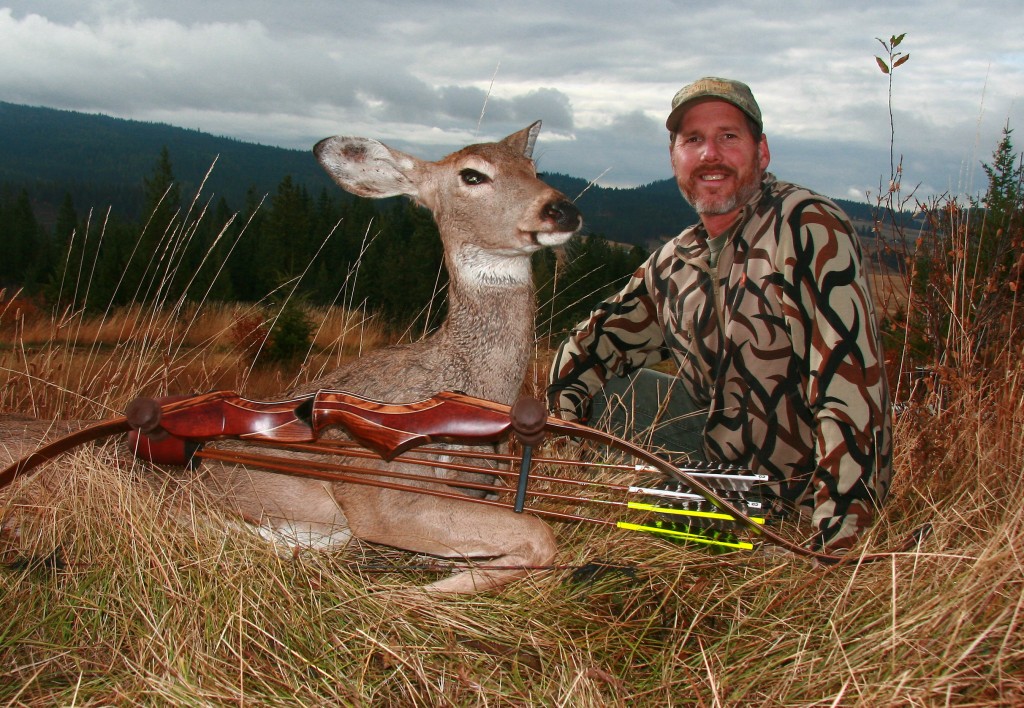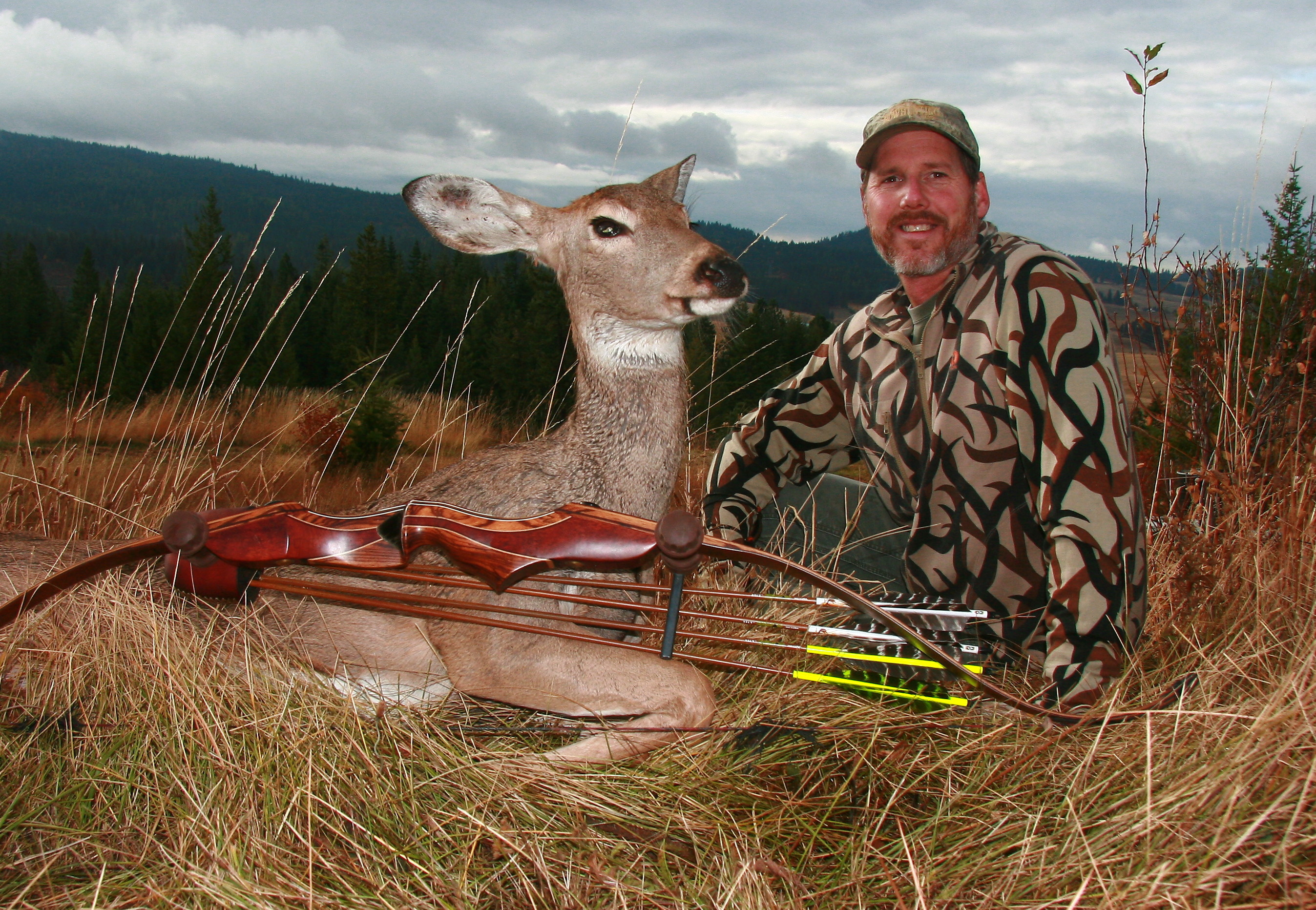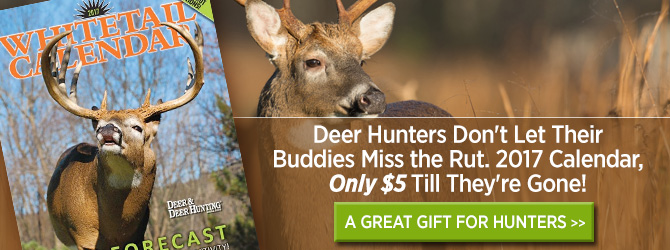
I’m falling head first into hard-frozen ground littered with head-sized rocks, stumps and dead branches. I regain my senses just soon enough to tuck hard, pivoting my right shoulder into the ground, pulling my head into my chest.
And then it is black.
The whitetail rut is out of the gates in northern Idaho, but I’ve ignored some trail cameras situated on lower, traditionally productive private ground. We have suffered an exceptionally hot and dry summer, conditions particular to that area producing a devastating outbreak of blue tongue. Few bucks have appeared on camera during earlier seasons. I’ve tagged a massive-bodied, 61⁄2-plus-year-old buck, but have a second tag in my pocket — the expensive nonresident leftover one. My public-land stands have simply gone dead since, causing some amount of urgency.
The little voice in my head has been nagging me to check those neglected cameras for a couple of weeks; and, of course, that voice is right. It usually is. When I finally get around to it one of those lower spots has not one behemoth buck appearing with regularity, but three — a 140ish 4×4 with corkscrew G3s, a high-framed 4×4 scoring much better and a non-typical whose score I can only guesstimate, say pushing 160.
I have monitored this spot for years; have captured images of some high-scoring bucks there, but never with enough regularity to justify hanging a stand. I am now paying for that oversight. It’s a sensitive spot, a corner of thronged vegetation holding a nearly invisible logging skid skirting an irregular agricultural field well interspersed with fingers of CRP. Based on the timing of the captured images (uniformly 8 to 9 a.m.), I gather these bucks are bedding — bedded — not too far away.
I slip back in around 1 p.m., isolate the only viable stand tree, a living but sickly white downhill fir, and as quietly as possible install two strap-on ladder sections on the lower portion of the tree, using mostly existing branches, and only two screw-in steps to climb to maybe 45 or 50 feet. I cut nothing, afraid of creating noise. This is a typical Idaho mountain whitetail setup, hanging stands at nose bleed heights to address targets slightly below and 20 yards away. I strap on the Millennium M60U’s mounting strap/receiver, slip the stand home and insert the locking pin, cringing every time I produce a metallic clank. I finish by installing a Hunter Safety System anchor strap above the stand.
I guard the new site two mornings, on the third climbing aboard an hour ahead of daybreak, clipping in and zipping up tight against single-digit temperatures and a biting wind, the world coated in crunching hoar frost and appearing like exposed infrared 35mm film in the weak half-moon. Reviewing trail camera images the night before has made it easy to bounce out of bed at 3:30 a.m., my eyes opening minutes before the alarm sounds, as happens after months of non-stop bowhunting.
I quietly unwrap a chemical hand warmer and stash it in the kangaroo pocket of my Sitka Gear Fanatic jacket, the one designed around Windstopper and Primaloft insulation and conceived for just such conditions.

BAKED-IN CATASTROPHE
It proves yet another dead morning, in fact, downright boring. Not even a doe appears, despite steady and advantageous winds. Doubts begin to creep in. Have I spooked these bucks while installing the stand, even as careful as I have been? Have I missed the boat, the estrous doe that has sparked the temporary action bred and those bucks off on other missions? Am I unknowingly bumping deer on my way into the stand? And where is the battery for my Gerbing heated vest anyway? My toes have turned numb and chills are beginning to take hold. I need to check some trail cameras, to see if these bucks are appearing near other stands. All these thoughts, as well as developing contingency plans, float through my head as I force myself to sit until 10:30 a.m., on the dot.
Normally, after clipping my bow to a pull-up rope and lowering it to earth before departing any stand (especially one as treacherous as this one) I give myself a little pep talk. OK, I tell myself. Pay attention to what the hell you’re doing. This could kill you.
This morning, my mind full of thoughts on where these bucks might have gotten off to, what I might have done wrong, cameras I need to check, the fact that only seven days remain of season and then the beginning of nine months of off-season hell, I forget the pep talk, unclip and start down.
I honestly can’t tell you exactly what happens next, other than a branch breaks.
I hold a wrist-sized branch in my right hand and it breaks suddenly. My cat-like reflexes do not save me, as I have always assumed would happen, as has actually happened while hanging stands during warm summer days. I’m falling, enveloped by the terrorizing realization that this isn’t going to end well. I bounce through a couple unforgiving branches, branches that tear at my face and right arm, then free fall with the ground closing quickly over my left shoulder.
I’m falling head first into hard-frozen ground littered with head-sized rocks, stumps and dead branches.
I regain my senses just soon enough to tuck hard, pivoting my right shoulder into the ground, pulling my head into my chest.
And then it is black.

AM I STILL ALIVE?
I come to, cold and hurting. I sit up, my Rancho Safari Catquiver Mini and the six arrows it held shattered beneath me. I pull at the sleeve cuff at my left wrist to note the time, stabbing pain shooting through my right arm. I’ve been out exactly four minutes. I stand, walking in circles momentarily, trying to regain some equilibrium. I start toward my truck, think better of it, return to recover my bow, gathering the broken remains of my back quiver and arrows, tucking the bow beneath my throbbing right arm, clutching quiver and arrows in my left. I walk 100 yards and discard the arrows and broken quiver. It somehow seems important to hold onto my bow. I turn the truck around painfully, and drive home.
Wifey is not pleased, roughly pulling my heavy insulated duds off to inspect the damage, me trying to be a tough guy but in serious pain, asking her to take it easy.
“You realize I had no idea where you were?” she demands.
“There’s no way to tell you where I was. No one could find that stand without me taking them there.”
“What if you’d broken your neck and were lying out there paralyzed?”
“Well, I’d be dead. And if I was paralyzed, I’d just as soon be.”
This is not what Wifey wants to hear. Oh, she’s upset all right.
WATCH: HOW TO SAFELY PUT UP A DEER HUNTING TREESTAND BY YOURSELF
THE PROGNOSIS
After a round of X-rays and a CAT-scan to inspect my noggin, it’s revealed I have no broken bones or concussion. After relating to the attending physician how far I’ve fallen, at least 35 feet by my best estimates, I’m sent in for a second round of X-rays before deemed fit for discharge. I have dodged the bullet — or so I believe. But my season is finished — including an anxiously anticipated foray to Texas. When I notify my friend I will not be coming to Texas, he promptly kills the buck he has been saving for me — 148 inches and change. And, of course, when I retrieve those cameras months later, every one of those bucks had been making regular appearances shortly after my fall.
Two months later the pain persists. I still cannot raise my right arm above 90 degrees. Another doctor prescribes an MRI, which tells the real story. The list of injuries is extensive: massively torn rotator cuff, two detached tendons, four major muscle tears, frozen shoulder. A broken arm would’ve been preferable.
Surgery goes well, six months of excruciating physical therapy follows and I spend the spring “bowhunting” with a crossbow. By September I’m shooting a “real” bow again — a 50-pound compound. Whether I’ll ever get back to the 70 pounds I once shot is a big question mark, though that doesn’t seem to be as important as I once thought. I kill a gorgeous Idaho non-typical with my bow Sept. 4 (2016) — complete penetration, quick recovery and all that. I kill another respectable buck in Illinois in October. I enjoy my annual Texas foray.
THE AFTERMATH
But in the age of Obamacare not all is fairy dust and unicorn farts. This little episode ultimately costs us $17,000 out of pocket and put us in a financial hole that we will be climbing out of for at least another year.
I broke a lot of basic rules all treestand hunters should live by. Not telling anyone where I was hunting. Very bad. Using branches for steps. Downright stupid. No pep talk before my descent. Not adhering to the three-points-of-contact rule.

I’ll now include an additional caveat, which I now adhere to any time my feet leave the ground: a Life-Line. Life-Line is Hunter Safety System’s brand name, but many companies now offer them; Millennium, Muddy Outdoors and Scent-Blocker/Tree Spider but a few. This is simply stout climbing rope attached above the treestand and to the base of the tree. This rope holds a simple, sliding prussic knot. The hunter clips in at the base of the tree, sliding the knot up and down the rope while coming and going. At any time should you slip, the knot cinches tight and arrests your fall.
It’s cheap insurance and causes little inconvenience. After my fall, I ordered a couple dozen (for considerably less than $17,000) and now install them on every stand I hang, even inherently safe ladders. The only real danger I now face regarding treestands is while initially installing them, though careful use of a lineman’s rope (clipped in at waist at right hip, wrapped around tree trunk and attached to waist at left hip) makes even that chore relatively safe.
You might say I was simply due, that it was my turn. But this need not be the case. Every season whitetail hunters are seriously injured or die from treestand falls. Don’t become a statistic. Treestand safety requires only slightly more effort, and at the very least assures no interruption of future hunting plans.
AWESOME SAFETY HARNESSES
The cornerstone of every safe treestand experience is a four-point safety harness. Not a waist strap, or a rope tied around your chest, but a quality four-point harness (two shoulders, two hips equaling four points) designed to keep you upright in the event of a fall. It is just suicidal to be hunting from any elevated position without wearing and using a top-notch safety harness. The best also include tether systems designed to absorb or lessen the severity of the shock of a fall when the tether comes up tight.
Some names to live by (and my favorites) include Hunter Safety System (UltraLite Flex with Elimishield Scent Control Technology), Gorilla Gear (Ghost Ultralight), Muddy Outdoors (Safeguard), Summit Treestands (Seat-O-The-Pants STS Fastback) and Scent- Blocker Tree Spider (Micro Harness) — all light enough to wear beneath insulated clothing.
LIFE-SAVING SAFETY LINES
A simple safety line — normally 30 feet of stout rope looped above the stand and tied at the base of the tree, and holding a sliding prussic knot — can reduce treestand accidents to just about zero. This is a simple system that catches you should you slip or fall at any point during your accent or descent.
Lately most safety-line systems also include reflective material woven into the rope to light up when hit with a flashlight beam, helping locate stands more easily when walking in during dark hours in preparation for morning hunts. The best also include designs that eliminate alarming carabineer clank against stands or ladders.
Look to Hunter Safety System (LIFE-LINE, with rubber carabineer bell to guard against deer-spooking clanks), Gorilla (Fall Defense Line, with silent-coated O-ring, self-locking carabineer and reflective material), Muddy (The Safe Line), Millennium (SafeLink) and Tree Spider (Safety Line, with reflective material) for such life-saving safety ropes.
— Patrick Meitin is a widely traveled bowhunter and former big game hunting guide. He hails from northern Idaho.


